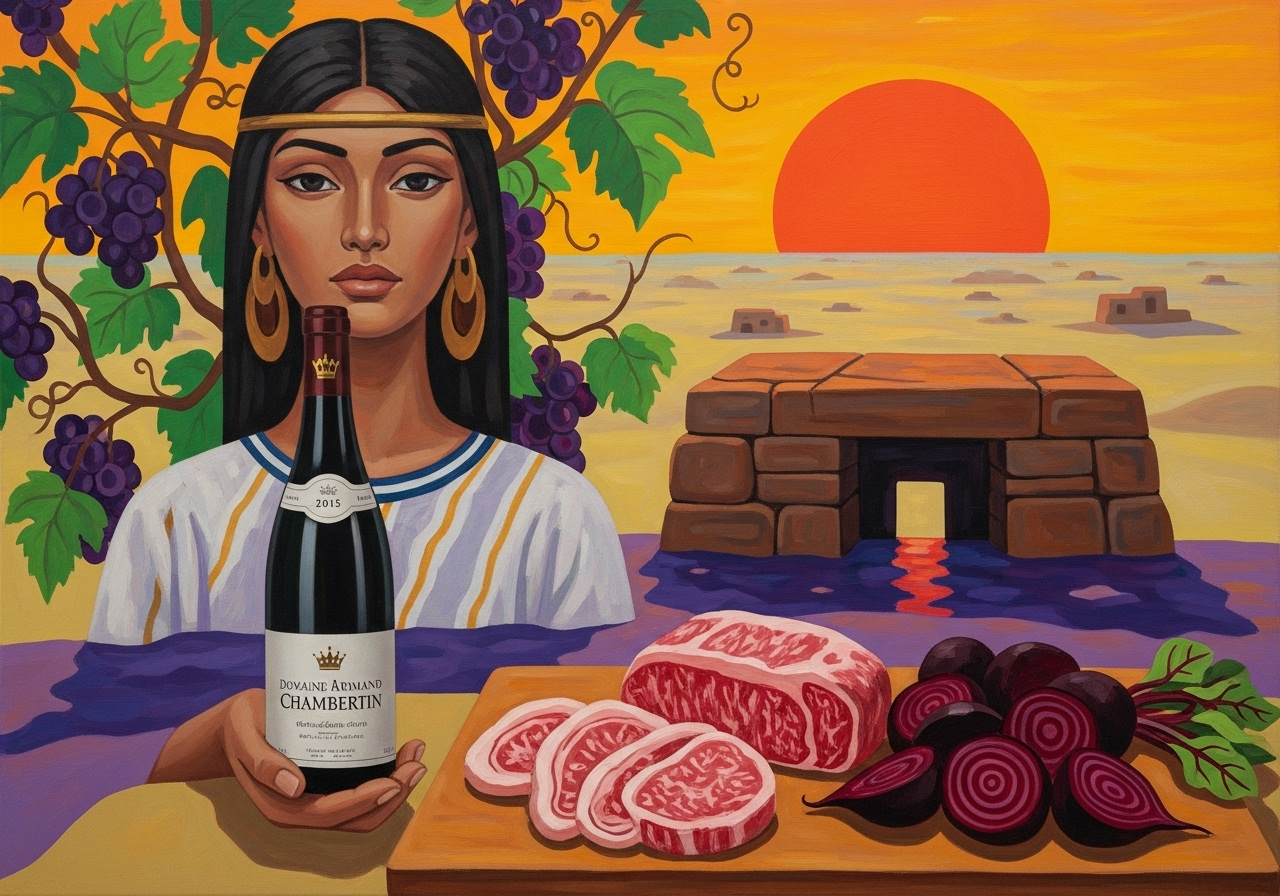The Vine’s Whisper in Stone: Domaine Armand Rousseau Chambertin 2015
Unique Domaine Armand Rousseau Chambertin 2015 food pairing ideas—wild boar, wagyu, truffle velouté, aged cheeses, and more—for wine of mythic depth.

The cork sighs as I free it, as though exhaling centuries of Burgundian earth. In the bowl of glass—broad as the moon’s curve—the wine shimmers garnet with a ruby edge. One hour in the decanter loosens the graphite threads, softens the youthful sternness of tannin, and allows its voice to swell. At 16–17 °C it sings most clearly: scents of black cherry skin, crushed rose petal, and the iron tang of wet stone rise like offerings. Already eloquent, it requires patience to reveal its true lexicon.
In Burgundy’s Côte de Nuits lies Chambertin, a grand cru spoken of in reverent tones, its vineyards cradled in limestone and clay. Domaine Armand Rousseau has long been its guardian, shaping Pinot Noir with a philosophy of restraint. Founded in the early 20th century, the estate has passed from Armand to his heirs, each generation tending vines with a steady hand, letting the soil—not the cellar—dictate the tale. The climate’s rhythm of warm ripening days and cool nights forges wines that balance muscle with lyricism, endurance with grace. Chambertin itself is a terroir of paradox: austere yet generous, structured yet expressive, forever demanding patience before unveiling its beauty.
The 2015 season was a gift: generous sunshine yet tempered by fresh nights. Rousseau’s Chambertin from this vintage is both stately and magnetic. On the nose, black cherry and damson mingle with sandalwood, dried violets, and a breath of forest floor. The palate is taut, with fine-grained tannins and a mineral backbone that courses through like a hidden river. Acidity brings clarity, keeping the wine vivid rather than heavy. Its finish stretches long, deliberate, like the lingering cadence of a chant. Drink now with ceremony, or watch it deepen into truffle and leather through 2030–2040.
When Flame Meets Forest
This Chambertin, forged of stone and velvet, deserves not the commonplace but the singular. Roast wild boar, glazed with juniper and honey, finds its echo here—the boar’s richness tempered by tannin, the resinous spice entwined with the wine’s dark fruit. Or think of pigeon, slow-roasted and served with a jus of blackcurrant: the bird’s lean flesh draws forward the Chambertin’s mineral core, while the berry sauce mirrors its fruit with uncanny precision. These dishes are not merely meals but rituals—offerings to match the wine’s gravitas.
Echoes Across Borders
Chambertin’s balance of depth and brightness allows it to travel beyond its Burgundian home. Consider Japanese wagyu, marbled and seared over binchōtan charcoal: the fat melts into silk, softening the tannin, while smoke binds to the wine’s earthy shadow. Or venison saddle with a coffee and cocoa rub, where bitterness and richness entwine with Pinot’s cherry and spice, amplifying both dish and glass into something mythic. In these unions, Chambertin becomes a diplomat, speaking fluently across cultures without losing the accent of its stony birthplace.
Offerings of Earth and Silence
The vine goddess delights also in the humble made radiant. Black truffle shaved over a chestnut velouté creates a harmony of forest and fruit—the Chambertin’s sous-bois notes entwining with the soup’s velvet. Grilled king oyster mushrooms brushed with miso caramel conjure a different union: umami and char awaken the wine’s darker timbres, while acidity lifts the dish from heaviness into resonance. These are foods that echo the underworld—root, fungus, darkness—and bring them to the light of the table.
For those seeking further communion, aged Comté or a slice of Époisses can prove transcendent. The former’s nutty depth draws out Chambertin’s mineral line, while the latter’s pungency, softened by the wine’s acidity, becomes less an assault than a meeting of equals. In these encounters, the wine is not dominant but responsive, adapting like water finding its path through stone.
Ritual Companions
At the table’s edges, indulgence can be quiet yet profound. Sunchoke purée, silken with butter, sharpens the wine’s mineral clarity with each mouthful. Or pommes dauphine—those airy puffs of potato and choux—bring both levity and fat, offering the Chambertin a playful partner. Even roasted beetroot, caramelized and dusted with fennel seed, can find harmony here: its sweetness balanced by the wine’s structure, its earthiness mirrored by Pinot’s depth. These are not side notes but verses in the same hymn, interludes that keep the palate awake and the conversation alive.
The Goddess in the Glass
I have walked both realms: half my year among vines and light, half in the underworld where roots whisper in silence. Rousseau’s Chambertin carries both worlds—the fruit of sun and the gravity of stone. To open such a bottle is to honor cycle and sacrifice. It is Persephone’s return, my own descent and ascent bound in liquid form. When you taste the mineral line, you taste the underworld ledger I keep. When the cherry rises, it is the song of spring returning to fields once barren.
Let it breathe as I once did when I descended; let it be heard in the right vessel, at the right hour, with foods that respect its dual nature. Drink it in reverence, knowing it will continue to evolve, softening like the return of spring after a long descent. Each glass is both lament and hymn, a reminder that beauty is often born of tension—between darkness and light, silence and song, root and vine.





